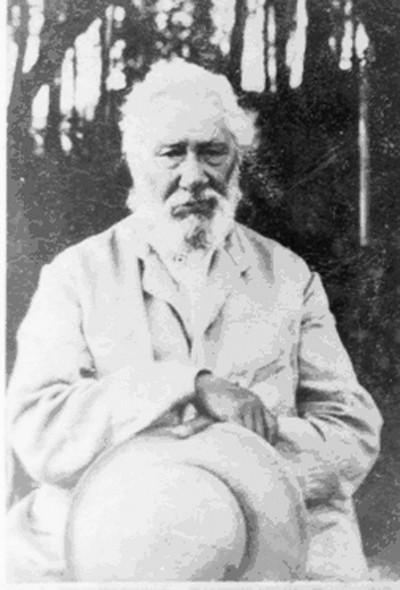WHAT DO THE GARDENS NEAR MOGILEV RUSTLE ABOUT?...

WHAT DO THE GARDENS NEAR MOGILEV RUSTLE ABOUT?...
To the 205th anniversary of Professor Eduard Rego
The gardens are rustling in the Mogilev region. Apple trees, pears, plums, cherries entered our lives as an integral part of it. But in the middle of the nineteenth century things were different. Fruit trees grew only in individual estates and were mostly decorative. It's thanks to the first plunt breeder in Belarus Eduard Rego who applied his knowledge and hands to make the gardens bloom in the Mogilev region.
In 1836, the Russian government in Gorki, known at that time as Gory-Gorki, decided to establish an agricultural school, which opened in 1840 and trained land stewards and agronomists. In 1848, the Agricultural School was reorganized into Agricultural College - at that time the first agricultural higher educational establishment in the Russian Empire. Many specialists were invited as lecturers. Eduard Rego was one of those.
Eduard Rego was born on May 24, 1816 near Riga. Originally he comes from the Baltic Germans. After graduating from the University of Derpt, Eduard became the first associate professor of botany, and then (since 1845) a professor at the school of botany, a famous scientist in the field of selection. When he arrived in Belarus, he was struck by the absence of fruit trees in rural areas. Only in some farms there were gardens, and most likely decorative ones. Therefore, he immediately began to spread the gardening. To do this, he published manuals for gardening, and in the nursery he carried out selectin work and distributed seedlings. Back in 1840, the botanical garden was designed in the regular style by the architect-builder Angelo Campioni. The introduction of the project into nature, the formation of collections and picturesque park landscapes was carried out by the associate professor of the Gory-Gorki Agricultural College Eduard Rego.
Thanks to the efforts of E.F.Rego, the botanical garden had unique collections of larch, pine, cedar, fir, poplar, willow, lilac, etc. The collection included about 900 plant species from various ecological and geographical zones. E.F. Rego took part in the creation of a park in Gomel near the Pashkevich Palace. His works on pomology and phytopathology, dendrology are well known. The "Agricultural Newspaper" said, that a seed depot had been opened at the Gory-Gorki Agricultural College and its training farm since the fall of 1858, under the closest command and responsibility of the botany teacher, associate professor Rego. The head of the seed depot, according to the rules, assumed the obligation to always have for sale to those wishing a sufficient supply of various kinds of seeds and plants: spikes, dyeing spicy, flower, young trees and grafting cuttings of fruit, berry bushes, trees and shrubs, serving for decoration, etc.; trying to acquire new varieties of seeds, to test them in advance in the College's gardens, and if they prove to be worthy of distribution, to announce this by adding instructions on how to plant and reproduce good varieties of seeds and plants and to sell them at as low prices as possible, thereby satisfying the requirements of everyone and earning a general trust. Professor E.F. Rego made an attempt to trace the origin of fruit and vegetable crops from wild crops, determined the importance of selection. He published several books. In 1860, the book "The Natural History of the Plant Kingdom, Mainly in Application to the Russian Flora of the Middle Provinces" was published. It is intended as a determinant, including more than 1000 descriptions of plant species. The book with drawings made by Schubert and Hochstetter was published in Moscow, in the Printing House of Katkov and Co. Beautifully made with water-soluble paints, plant patterns have not lost brightness in more than 150 years of their existence. Professor E.F. Rego owns the phrase: "Clarity depends on the form and structure of books, accuracy on the integrity of the person involved." In his language, it can be said that this determinant is distinguished by a well-thought clear organization. The second edition of "The Natural History of the Plant Kingdom, Mainly in Application to the Russian Flora of the Middle Provinces," was published in St. Petersburg in the printing house of S. Khotinsky in 1865 on 198 pages with color illustrations and tables.
E.F. Rego also conducted research in the fruit garden near his estate in Korovchino. In addition to gardening, E.F. Rego first designed and built greenhouses with water heating and the original installation of racks that allowed to uniformly illuminate plants. In 1870, his work "Practical Instruction on Agricultural Accounting" was published. In it, he opposed double accounting in agriculture.
Eduard Rego is famous as a scientist in the field of botany and horticulture, he is the author of many scientific works. He was awarded the Order of St. Vladimir 4th degree, the Order of St. Stanislav 2nd degree with the Imperial Crown and the Order of St. Anne 2nd degree, as well as a medal in Memory of the war of 1853-1856. He was a state adviser. The Imperial Order of the Holy Equal-to-the-Apostles Prince Vladimir in 4 degrees was awarded for military distinctions and civil merits. Since 1845, those awarded the Order of St. Vladimir of any degree received the rights of the hereditary nobility.
Eduard Rego died on July 15, 1892 in his estate in the village of Korovchino and was buried in the village cemetery. The place of the grave has been lost. Only two larches near the estate site and several old apple-trees remind of one of the highly developed farms of the Mogilev region, awarded the first prize at an agricultural exhibition in Russia.
Leonid OSIPOV.













